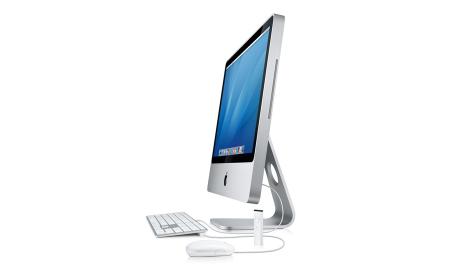Apple Releases New Aluminum iMacs, Refreshes Mac mini
In last week’s “special event” presentation, Apple CEO Steve Jobs whipped through the announcement of the much-anticipated new iMacs with an almost cursory spin through a change in industrial design that updates the current iMac look. The new iMac comes in 20-inch and 24-inch models (bye-bye, 17-inch iMac), is much thinner, and is built largely of glass and a single sheet of aluminum instead of the previous white polycarbonate. In a nod to the recent hullabaloo about Apple’s green credentials (see “Steve Jobs Talks Green,” 2007-05-07), Jobs even called attention to the fact that the two materials are highly recyclable.
As with the previous iMac models, the new iMac includes a built-in iSight video camera and microphone, an infrared port (with an Apple Remote for talking to it), and a slot-loading SuperDrive (with dual-layer support). In a row along the back, the new iMac offers audio input and output jacks, three USB 2.0 ports, one FireWire 400 and one FireWire 800 port, gigabit Ethernet, and DVI video out (you’ll need a separate adaptor, for about $20, if you want to use it). 1 GB of RAM is standard, upgradable to 4 GB (by removing just one screw, the only one that’s visible), and 802.11n wireless networking and Bluetooth 2.0 are built-in. Base models are accompanied by a keyboard (for more about that, read on) and Mighty Mouse. In a move that may be
controversial, the glossy screen is also standard.
The 20-inch iMac at $1,199 includes a 2.0 GHz Intel Core 2 Duo processor and a 250 GB hard drive with an ATI Radeon HD 2400 XT graphics card with 128 MB of GDDR3 memory; switching to a 2.4 GHz Intel Core 2 Duo, a 320 GB drive, and an ATI Radeon HD 2600 Pro with 256 MB of GDDR3 memory increases the price to $1,499. The 24-inch iMac drops in price by $200 to $1,799 and includes the same 2.4 GHz Core 2 Duo processor, 320 GB hard drive, and ATI Radeon card as the mid-level model. A souped-up version of that model with a 2.8 GHz Core 2 Extreme processor, 500 GB hard drive, and 2 GB of RAM costs $2,299. You can also purchase the base 24-inch model with a 2.8 GHz Core 2 Extreme for an additional
$250. All the new models are currently available, and include the just-released iLife ’08.
As far as we can tell, the Core 2 Extreme processor used in the new iMac differs primarily from the Core 2 Duo in clock speed, although it also features something called an “unlocked multiplier” that enables it to be over-clocked to run at higher clock speeds for greater performance. Although there are quad-core instances of the Core 2 Extreme, Apple appears to be using only a dual-core version. Interestingly, the fact that the Core 2 Extreme used in the iMac has an 800 MHz front-side bus points to it being the X7800, which Intel lists as running at a 2.6 GHz clock speed, suggesting that Apple has taken advantage of the unlocked multiplier to clock it up to
2.8 GHz.
Apple also released the new Apple Keyboard, an incredibly thin input device that’s reminiscent of the keyboard used in the company’s laptops (it’s only 0.33 inches/8.3 mm tall, as opposed to the 0.99 inch/25.1 mm height of the previous Apple Pro keyboard). The $49 wired model, which accompanies the new iMacs in their base configuration, uses USB (and provides a pair of USB 2.0 ports); a $79 wireless model, available with the iMacs as a build-to-order option, relies instead on Bluetooth, while dropping the USB 2.0 ports. Both keyboards offer, along with all the usual keys, dedicated keys for Mac OS X features like Exposé and Dashboard, along with media keys for play/pause, eject, brightness,
and volume.
Also refreshed was the Mac mini, which switched from a choice of 1.66 or 1.83 GHz Core Duo processors to 1.83 GHz or 2.0 GHz Core 2 Duo processors. The base model includes 1 GB of memory, up from 512 MB and expandable to 2 GB. Other features remain unchanged, including only 802.11g Wi-Fi, and four USB 2.0 ports.

